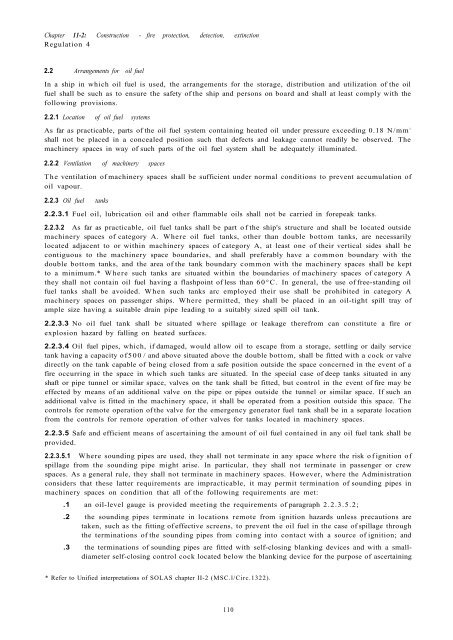Solas Consolidated Edition 2009.pdf
Solas Consolidated Edition 2009 for maritime
Solas Consolidated Edition 2009 for maritime
Create successful ePaper yourself
Turn your PDF publications into a flip-book with our unique Google optimized e-Paper software.
Chapter 11-2: Construction - fire protection, detection, extinction<br />
Regulation 4<br />
2.2 Arrangements for oil fuel<br />
In a ship in which oil fuel is used, the arrangements for the storage, distribution and utilization of the oil<br />
fuel shall be such as to ensure the safety of the ship and persons on board and shall at least comply with the<br />
following provisions.<br />
2.2.1 Location of oil fuel systems<br />
As far as practicable, parts of the oil fuel system containing heated oil under pressure exceeding 0.18 N/mm 2<br />
shall not be placed in a concealed position such that defects and leakage cannot readily be observed. The<br />
machinery spaces in way of such parts of the oil fuel system shall be adequately illuminated.<br />
2.2.2 Ventilation of machinery spaces<br />
The ventilation of machinery spaces shall be sufficient under normal conditions to prevent accumulation of<br />
oil vapour.<br />
2.2.3 Oil fuel tanks<br />
2.2.3.1 Fuel oil, lubrication oil and other flammable oils shall not be carried in forepeak tanks.<br />
2.2.3.2 As far as practicable, oil fuel tanks shall be part of the ship's structure and shall be located outside<br />
machinery spaces of category A. Where oil fuel tanks, other than double bottom tanks, are necessarily<br />
located adjacent to or within machinery spaces of category A, at least one of their vertical sides shall be<br />
contiguous to the machinery space boundaries, and shall preferably have a common boundary with the<br />
double bottom tanks, and the area of the tank boundary common with the machinery spaces shall be kept<br />
to a minimum.* Where such tanks are situated within the boundaries of machinery spaces of category A<br />
they shall not contain oil fuel having a flashpoint of less than 60°C. In general, the use of free-standing oil<br />
fuel tanks shall be avoided. When such tanks arc employed their use shall be prohibited in category A<br />
machinery spaces on passenger ships. Where permitted, they shall be placed in an oil-tight spill tray of<br />
ample size having a suitable drain pipe leading to a suitably sized spill oil tank.<br />
2.2.3.3 No oil fuel tank shall be situated where spillage or leakage therefrom can constitute a fire or<br />
explosion hazard by falling on heated surfaces.<br />
2.2.3.4 Oil fuel pipes, which, if damaged, would allow oil to escape from a storage, settling or daily service<br />
tank having a capacity of500 / and above situated above the double bottom, shall be fitted with a cock or valve<br />
directly on the tank capable of being closed from a safe position outside the space concerned in the event of a<br />
fire occurring in the space in which such tanks are situated. In the special case of deep tanks situated in any<br />
shaft or pipe tunnel or similar space, valves on the tank shall be fitted, but control in the event of fire may be<br />
effected by means of an additional valve on the pipe or pipes outside the tunnel or similar space. If such an<br />
additional valve is fitted in the machinery space, it shall be operated from a position outside this space. The<br />
controls for remote operation of the valve for the emergency generator fuel tank shall be in a separate location<br />
from the controls for remote operation of other valves for tanks located in machinery spaces.<br />
2.2.3.5 Safe and efficient means of ascertaining the amount of oil fuel contained in any oil fuel tank shall be<br />
provided.<br />
2.2.3.5.1 Where sounding pipes are used, they shall not terminate in any space where the risk of ignition of<br />
spillage from the sounding pipe might arise. In particular, they shall not terminate in passenger or crew<br />
spaces. As a general rule, they shall not terminate in machinery spaces. However, where the Administration<br />
considers that these latter requirements are impracticable, it may permit termination of sounding pipes in<br />
machinery spaces on condition that all of the following requirements are met:<br />
.1 an oil-level gauge is provided meeting the requirements of paragraph 2.2.3.5.2;<br />
.2 the sounding pipes terminate in locations remote from ignition hazards unless precautions are<br />
taken, such as the fitting of effective screens, to prevent the oil fuel in the case of spillage through<br />
the terminations of the sounding pipes from coming into contact with a source of ignition; and<br />
.3 the terminations of sounding pipes are fitted with self-closing blanking devices and with a smalldiameter<br />
self-closing control cock located below the blanking device for the purpose of ascertaining<br />
* Refer to Unified interpretations of SOLAS chapter II-2 (MSC.l/Circ.1322).<br />
110


